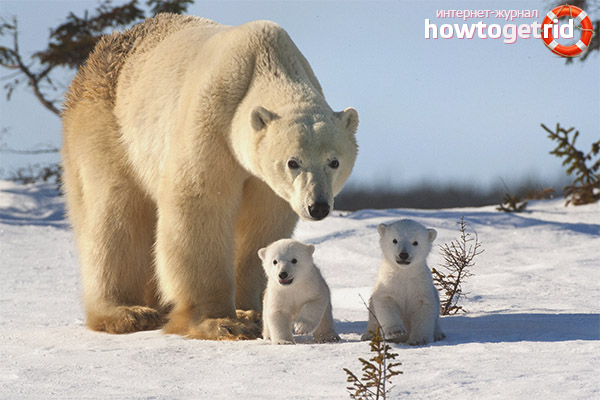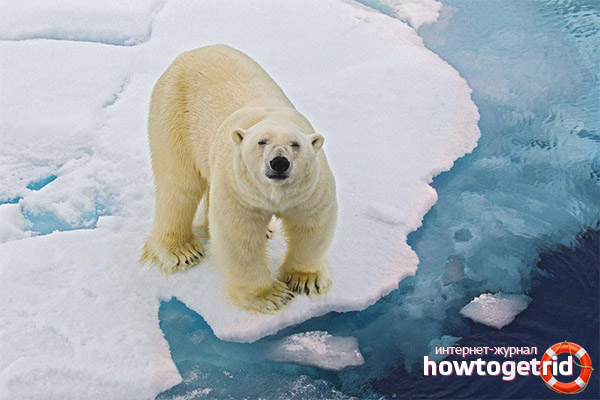The content of the article
The Arctic may seem a lifeless space, but in this snowy expanse there are also inhabitants of it. In particular, the polar bear.
Basic information
The Latin name of this animal literally sounds like a sea bear, and this name is quite relevant, since polar bears feel great in the water. They can hold their breath for a minute, quite calmly and swim in cold waters, they perfectly manage their own body there. Throughout its existence, the polar bear often uses not only terrestrial snow, but also watery spaces for moving and searching for food.
The polar bear is the largest predator on the planet, but the size may vary depending on the region of habitat. As a rule (statistically), the smallest individuals live on Svalbard, and the largest (whose body reaches up to three meters in length) are found in the Bering Sea. The mass of a large male can be about half a ton or more.
A distinctive feature of this bear is a special thick wool, which provides resistance to cold. It must be said, these animals often find themselves in a situation of temperatures around -60 and with active winds up to 160 km / h, so special tools for survival are needed here.
Bear fur consists of two layers and covers the body completely, even the inner side of the ears and the lower part of the paws. The hairs are filled with air, as they have a hollow structure. This creates a special air gap between the body of the bear and the outer space. In addition, a significant role has subcutaneous fat, which is something like underwear. In general, the body warms itself.
Huge paws are crowned with claws up to 20 centimeters long. Also, bears have a number of fairly massive teeth, which provide the necessary benefits for getting and cutting food.
Bears live in fairly warm and cozy dens, which are located deep in the snow layer and allow you to warm up and raise offspring in the warmth.
Polar bear behavior
Polar bears are loners, they are not inclined to form flocks, prides or something similar. They are not characterized by competition within the framework of their own kind, and especially open aggression (if you do not take into account the marriage period).
For people, they are quite dangerous and people are not afraid, therefore, whenever possible, meetings with polar bears should be avoided.
If we are talking about Arctic bears, they spend a lot of time on the ice, moving from ice floe to ice floe. In general, polar bears easily equip their dens in the snow and love to travel.
A distinctive feature of this species is the ability to perfectly dive in cold water and overcome significant distances in the harsh conditions of the north.
In winter, they fit into their own lairs, but do not hibernate, just reduce activity. In fact, about two-thirds of the polar bear’s existence is a dream or a wait for prey, that is, actually a measured inaction.
Typical food
Bears are carnivorous, that is, they eat the meat of other animals.In fact, only this option is only possible for two reasons:
- In the Arctic, there are practically no plants and vegetable food is not optimal for the cold, only in the summer, when the ice subsides and plants appear, bears eat grass, berries and the like.
- Only meat can provide the right amount of energy and allow you to be active in the cold.
Bears have no other choice, and eat other animals, mainly seals, of which there are a huge number in the Arctic:
- spotted;
- Greenland;
- Blue - considered to be the most delicious bears.
In order to fulfill the daily calorie intake, the beast needs about two kilograms of seal meat, but actually it’s not so easy to get that amount. Seals only look clumsy, but in fact are quite fast. In order to catch a seal, a bear needs to spend a lot of time under water and track down prey.
Such interaction is similar to an exciting strategic competition, in which not only physical qualities are necessary, but also experience and skill. The conditions of the competition are:
- The seal can remain in the water for a long time, but it still needs to inhale occasionally, approximately every 20 minutes.
- In order to get a portion of oxygen, the seals use small holes in the ice, which are slightly visible on the surface of the snow.
- Bears can smell the seal for 30 kilometers and are able to sense it through the water column.
- A seal can hear a bear walking on the ice.
- In order to catch prey, we need a tedious wait.
The essence of the process is not only to understand between which holes the seal swims, but also to be there imperceptibly and correctly to guess through which hole the seal will breathe again.
In addition, there are other ways to get food, but the main source is still seals. In fact, although bears have many advantages over prey, only one out of 20 hunts ends up getting food.
A much rarer option is to hunt larger marine creatures, such as beluga whales. These belugas gather in rather large flocks and are comparable in size to bears, so it takes a lot of effort to get such prey. Often, the hunt is completed only with a pair of scars on the body of a whale-beluga whale and no more.
The situation is similar with walruses. A large walrus is not often eaten by a bear because of its almost identical dimensions. If it is possible, then mainly fat and skin are eaten, and the remaining parts go to other animals.
More productive is the hunt for walrus pups. However, such an enterprise is undertaken quite rarely and only on land, where bears have an advantage.
In the summer, polar bears become almost omnivorous and can eat plants, carrion and much more.
The consumption of food that remains from expeditions or belongs to people is quite effective. Polar bears can easily open canned food with their claws, therefore they regularly study human garbage dumps, if they are available.
Regarding the topic of food, it should be noted the high reasonableness of these animals, which are perfectly able to stock and create storage. If there is more food than is required, then the bear does not leave the prey obtained (although it is often a small part of the remains that the scribes still get), but it stores and uses this warehouse in more severe times.Thus, they are easily able to provide themselves for very long periods and do not suffer from a lack of food.
Reproduction and development

At this period, these animals are listed in the Red Book and, although the population is gradually increasing, they are protected by the government of different countries. For example, in Canada, bears, which can be potentially dangerous and come pretty close to people's homes, are not shot, but put in a special bear prison.
Reproduction is rather slow and the development of the population also suffers from a significant number of deaths in young animals, sometimes also due to competition. Rarely there are situations when bears eat their young rivals in the mating season. In addition, simply harsh conditions limit survival.
It should also be noted external factors:
- Shooting by poachers - almost all parts are valued; a scarecrow is worth unimaginable money.
- Environmental causes - for example, some people call this a decrease in glaciers, as we know, the planet is a bit warmer, glaciers are melting, and bears have to overcome large distances between ice floes.
Nevertheless, a limited part of the population, one way or another, is maintained at a fairly stable level thanks to zoos and nature reserves.
Polar bear cubs are born very small and blind, and stay for a week in the den, much warmer than the outer space, and only then come to the surface. A bear feeds a newborn bear with its milk, which is 15 times fatter than cow's milk. Due to this, bear babies grow strong, healthy and quite active.
The fertile age of a bear comes at four years old, and she can give birth to only about fifteen babies. In one pregnancy, as a rule, only one bear cub appears. Sometimes two or three.
Throughout the period when the child matures, the mother continues to protect and teach him various skills. The fathers of polar bears, in turn, practically do not care about their offspring and, moreover, can even eat a child.
During estrus, the female travels over her own territory and is followed by a certain number of males, one of whom manages to get a location.
The period of existence of these animals is about 30 years.However, we are talking about wild conditions, and in captivity, but in optimal conditions, polar bears easily live much longer than this period.
Video: polar bear (Ursus maritimus)












To send